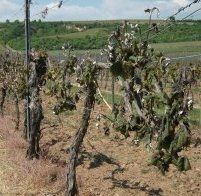2011 – frost details

9 May – Michael Schmidt adds from Germany:
In many wine regions of Germany, 4 May was a day of far-reaching significance. A drop in temperatures down to minus 5 ºC during the night caused considerable to severe damage in a number of regions. In Rheinhessen, the areas most affected were those on the plain of the river Rhein and valley floors. In Franken and Württemberg, losses are estimated to lie between 30% and 50%. In the regions of the Rheingau, Pfalz and Nahe, the prospective crop was reduced by 5% to 20%. In Baden, the district affected most severely was the Kraichgau. With regard to the members of the VDP association of German premium wine producers, their situation varies, depending mainly on the altitude of their different sites.
Least affected were the Mosel, Mittelrhein, Pfalz-Weinstrasse, Baden-Kaiserstuhl and the lower Ahr.
After having suffered a severely reduced harvest in 2010, some estates will face dire economic consequences, although there has already been talk of some government compensation.
Particularly badly affected by the frost were valley floors and slopes where the cold accumulated and remained for several hours due to a lack of air flow. The premium sector of German wine production will have got away relatively lightly, as historically most of the top-quality sites lie on the middle and upper slopes and at higher altitudes and are therefore less prone to frost attack.
* * *
The 2011 vintage in the northern hemisphere already seems to be acquiring a strong character of its own. Central Coast vineyards in southern California were very badly affected by frost in early April, as you can read here. And the unusually warm, dry early spring in Europe has resulted in much advanced vine growth, leaving the young buds and green shoots especially vulnerable to spring frosts too.
Joachim Binz reported yesterday that on Tuesday and Wednesday this week several German vineyards were badly hit by frost. 'Literally all regions in Germany are affected, some more than others. Due to the very dry and sunny weather (with hot temperatures from mid April to Easter), vegetation was already much in advance. Most producers are in their vineyardjs today to physically see how severely they are affected. After the very small harvest in 2010 this is something we did not need at all.'
The picture showing frost damage was taken in a vineyard in Kindenheim (northern Pfalz) on Wednesday of this week.

Become a member to view this article and thousands more!
- 15,428 featured articles
- 273,974 wine reviews
- Maps from The World Atlas of Wine, 8th edition (RRP £50)
- The Oxford Companion to Wine, 5th edition (RRP £50)
- Members’ forum
- 15,428 featured articles
- 273,974 wine reviews
- Maps from The World Atlas of Wine, 8th edition (RRP £50)
- The Oxford Companion to Wine, 5th edition (RRP £50)
- Members’ forum
- Commercial use of our Tasting Notes
